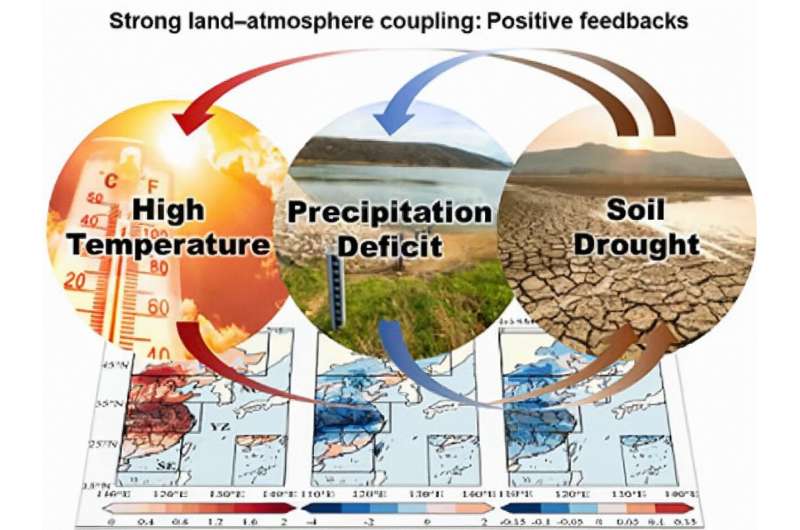This article has been reviewed according to Science X's editorial process and policies. Editors have highlighted the following attributes while ensuring the content's credibility:
fact-checked
trusted source
proofread
How the relationship between the land and atmosphere facilitated China's extreme weather in summer 2022

Extreme weather and climate events, such as droughts, heat waves, and rainstorms, pose serious threats to human health, agricultural production, and energy supplies. These events often occur at the same time, and such "compound extreme events" can cause far more damage than any one single event.
Climate scientists from the research group of Prof. Aihui Wang from the Institute of Atmospheric Physics, Chinese Academy of Sciences, Beijing, China, argue in a new study that land–atmosphere coupling (the coupling of the land surface and the atmosphere through processes such as evaporation, transpiration, and heat exchange) may have played an important role in the persistent compound extreme events witnessed in the summer of 2022 in eastern China.
The paper has recently been published in Atmospheric and Oceanic Science Letters.
Eastern China is not only a typical monsoon region, but also a hotspot of land–atmosphere coupling, both of which contribute to the challenge of accurately predicting extreme weather and climate events in this region. In this respect, land surface features are important sources of predictability on various time scales. Moreover, significant asymmetry exists in the feedback between these features and the atmosphere, which often plays a significant role in amplifying extreme weather and climate events.
In the summer of 2022, persistent high temperature and drought compound extreme events occurred in central and eastern China, affecting a wide area and lasting for a long time. Overall, the extreme heat lasted for 79 days, which was the longest since 1961, and the intensity was also the highest on record. Furthermore, the end time of these high-temperature events was later than it would normally be, and the severe summer and autumn drought in southern China had pervasive impacts on agriculture.
In their study, Prof. Wang and colleagues point out that the persistent high temperature, precipitation deficit, and soil drought occurred in eastern China during the warm season of 2023. Among them, the above compound extreme events maintained in the middle and lower reaches of the Yangtze River and southeast China from July to September, significantly deviating from the historical situation in the same period.
"Dry soil can be regarded as an important prior signal of subsequent high-temperature events, and the intraseasonal variation of land–atmosphere feedback can strongly regulate the persistence of such extreme events," explains Prof. Wang.
In humid regimes, such as the middle and lower reaches of the Yangtze River valley and the southeast China, evapotranspiration is mainly limited by the available energy over the land surface. In other words, the soil water content in these areas is abundant, and in general, the more radiation energy absorbed by the land surface, the stronger the evapotranspiration.
From mid-summer to early autumn of 2022, the available energy increased to such an extent that the limiting effect of soil water content on evapotranspiration gradually exceeded its long-term average. High temperatures reduced the soil moisture, while the dry land surface further heated the atmosphere in return through strong feedback. Meanwhile, high temperatures accelerated the loss of soil water by regulating evapotranspiration, which inhibited the formation of rain after July.
The findings of this study enhance our understanding of the processes underlying persistent extreme events and potentially offer insights into better predicting them.
More information: Yue Chen et al, Role of land–atmosphere coupling in persistent extreme climate events in eastern China in summer 2022, Atmospheric and Oceanic Science Letters (2023). DOI: 10.1016/j.aosl.2023.100419
Provided by Chinese Academy of Sciences



















